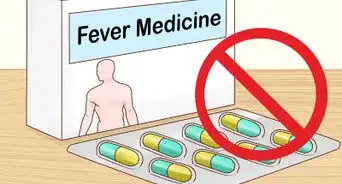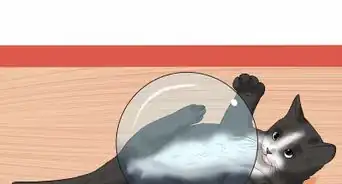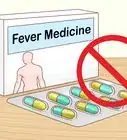This article was co-authored by Pippa Elliott, MRCVS. Dr. Elliott, BVMS, MRCVS is a veterinarian with over 30 years of experience in veterinary surgery and companion animal practice. She graduated from the University of Glasgow in 1987 with a degree in veterinary medicine and surgery. She has worked at the same animal clinic in her hometown for over 20 years.
This article has been viewed 44,851 times.
Feline panleukopenia, also known as feline distemper, is a serious, potentially life-threatening viral infection. The virus is very hardy, meaning it can survive for 12 months in the environment, and is resistant to many common disinfectants. Because of this, it is estimated that most cats will come into contact with the feline panleukopenia virus during their first year of life.[1] If you have a cat it is very important to understand this virus, how it is transmitted, the signs of infection, and how to treat it.
Steps
Identifying the Signs of Feline Distemper
-
1Keep an eye out for a high fever. The incubation period from being in contact with the virus to developing clinical signs is approximately four to five days. The first symptom to develop is a high fever, which can occur so suddenly that the owner suspects their cat has been poisoned.
- In adult cats that have a strong immune system or are vaccinated, they may contact the virus but keep it in check and not become ill.
-
2Watch for vomiting and bloody diarrhea to start. This is the most obvious sign that your cat may have distemper.[2] The diarrhea and vomiting is serious because it indicates distemper but it can also quickly lead to dehydration and anemia, serious problems on their own.
- If your cat vomits on a regular basis, for example due to hairballs, you will have to judge whether the vomiting your cat is doing is out of character or just its normal behavior.
Advertisement -
3Be on the look out for behavioral signs of distress as well. This illness will impact a cat's behavior, as it is likely to make them feel extremely ill. If your cat is extremely miserable and depressed and loses all interest in food, then you should suspect a serious illness, such as distemper.
-
4
-
5Be especially vigilant about looking for symptoms in those most vulnerable. Those most at risk are the very young, with immature or weak immune systems. Typically a three to five month old kitten that has not been vaccinated is most likely to succumb to serious infection.
- It is estimated that around 50 - 90 % of the cats that come into contact with the virus die as a result.[5]
Treating Feline Distemper
-
1Take your cat to a veterinarian immediately. The vet should be suspicious of feline distemper based on the symptoms you have witnessed. Reaching a precise diagnosis is not essential since there is no 'cure' for panleukopenia, as it's caused by a virus. It is up to the cat's own immune system to fight the virus, and treatment is based around supporting the cat until the immune system mounts a defense.
- However, the vet may want to run tests to rule out other causes of a high fever (such as FIP or bacterial infections) and check for a foreign body or other causes of bowel obstruction, such as an intussusception, which is a problem with the intestine that can cause sickness and diarrhea.
-
2Approve emergency treatment. If your cat is very sick, the vet may need to give it treatment very quickly in order to save its life. This treatment could include:
- Intravenous fluids: Aggressive intravenous fluids can help counteract dehydration. Given the extreme nature of the sickness and diarrhea, the cat may also become depleted in vital electrolytes, minerals, and glucose in the blood stream so these are added to the drip fluid as necessary, in order to normalize levels.[6]
- Plasma or blood transfusions: With severe cases, the cat can lose a dangerous amount of blood and become profoundly anemic and also protein depleted. Finding blood for blood transfusions in the cat can be difficult but where the clinic has the resources to source a blood donor and match blood types, a blood transfusion can be life saving.[7]
-
3Discuss treatment with antibiotics with the veterinarian. There are a variety of treatments that may be given to your cat. These are based around supportive care, which works to support your cat's immune system while it fights off the infection. For example, all distemper is a viral infection, but antibiotics are often given because the cat is so debilitated it is vulnerable to life-threatening bacterial infections.[8]
- Antibiotics are usually given by injection as the gut is compromised by the sickness and diarrhea.
-
4Give your cat antiemetics. This type of medication will make your cat more comfortable. They are given to help the cat feel less nauseous and reduce the amount of vomiting.[9]
- Antiemetics are anti-nausea medications, which include metoclopramide or maropitant.
-
5Allow the vet to give your cat B vitamins. Intravenous B vitamins helps promote good bowel health and can aid recovery. Like the other treatments for distemper, they support your cat's immune system in its fight against the infection.[10]
-
6Consider experimental treatments. For example, cats with distemper may be helped by Interferon. Although it is not licensed for use in cats for this purpose, Virbagen Omega interferon may have a place in the treatment of feline distemper. [11]
- It is licensed for this use in dogs and helps to strengthen the immune system to fight the infection.
Caring for an Infected Cat
-
1Give your cat after care at home. Nursing care is essential, such as keeping the cat warm on a heat pad, since extremely poorly animals are prone to losing heat and hypothermia.[12] Make sure your cat is as comfortable as possible while it works on recovering.
- The cat should be turned regularly, such as every half hour, and the side it is lying on changed. This reduces the risk of blood pooling on one side of the body, which can induce a form of pneumonia.
-
2Feed your cat a special diet during recovery. If the cat survives the acute phase of the illness, it should be reintroduced to bland food, such as a prescription diet designed for gastroenteritis (Hills ID or Purina EN) or white meat and rice. This is fed little and often until the cat has been producing a formed stool for 3 - 4 days, at which point a slow transition back onto regular food can start.[13]
-
3Prepare yourself for the worst case scenario. A very high percentage of cats who are infected with distemper, especially kittens, die. This is a very serious infection that requires a very strong immune system to eliminate.
- It is your job to care for the cat as best you can. This means making it as comfortable and pain free as possible.
Preventing Panleukopenia Infection
-
1Get your cat vaccinated. Highly effective vaccines are available that prevent panleukopenia infection. This is the most effective way to prevent your cat from getting this infection. The vaccine can be given from six to eight weeks of age and requires two doses, three to four weeks apart. [14] [15]
- Thereafter, the cat requires a booster after twelve months, and then vaccination every third year to extend the protection.
-
2Keep very young kittens isolated. Young kittens do not start their distemper vaccinations until they are around six to eight weeks old. They are born with some antibodies received from their mothers, but this is not a sure bet for keeping the distemper virus at bay. In fact, these natural antibodies can counteract this vaccination, allowing those kittens with early vaccinations to be susceptible to the disease. This is why it is important to keep small kittens away from other cats.
- It is best to keep kittens away from other cats, expect for their litter mates and their mother.
-
3Clean up cat waste in your yard. While it is not always evident that a cat has gone to the bathroom in your yard, if you see it you should clean it up. Many cats are outside cats and contact with other cat's feces can pose a health risk.
- Because the virus can be spread easily, it's also important to wash your hands before handling young kittens. This is especially important if you have been petting other cats recently.[16]
-
4Keep an infected cat isolated. Virus particles are excreted in infected feces, where they contaminate the environment and can remain infectious for years. Unfortunately, an added complication is that recovered cats can carry on excreting virus for six weeks after their recovery, providing yet more sources of infection for other cats.[17] Because of this, it's important to keep a recovering cat isolated from other cats, so that it does not infect them.
- If you have multiple cats in your house it is most likely that they are all infected if one is infected. However, it's important to isolate the infected cat completely if by chance your other cats are not infected.
Warnings
- Wildlife, such as mink and raccoons, can also carry the same virus. If you are worried about your outdoor cat getting distemper, it's best to dissuade wild animals from coming into your yard by putting up fencing and removing items they are attracted to.⧼thumbs_response⧽
References
- ↑ http://www.peteducation.com/article.cfm?c=1+2139&aid=222
- ↑ https://www.vetmed.wsu.edu/outreach/Pet-Health-Topics/categories/common-problems/diarrhea
- ↑ http://www.merckvetmanual.com/mvm/generalized_conditions/feline_panleukopenia/overview_of_feline_panleukopenia.html
- ↑ http://cats.lovetoknow.com/Distemper
- ↑ http://cats.lovetoknow.com/Distemper
- ↑ http://www.merckvetmanual.com/mvm/generalized_conditions/feline_panleukopenia/overview_of_feline_panleukopenia.html
- ↑ http://www.merckvetmanual.com/mvm/generalized_conditions/feline_panleukopenia/overview_of_feline_panleukopenia.html
- ↑ http://www.merckvetmanual.com/mvm/generalized_conditions/feline_panleukopenia/overview_of_feline_panleukopenia.html
- ↑ http://www.merckvetmanual.com/mvm/generalized_conditions/feline_panleukopenia/overview_of_feline_panleukopenia.html
- ↑ http://cats.lovetoknow.com/Distemper
- ↑ http://www.merckvetmanual.com/mvm/generalized_conditions/feline_panleukopenia/overview_of_feline_panleukopenia.html
- ↑ http://www.peteducation.com/article.cfm?c=1+2139&aid=222
- ↑ http://www.merckvetmanual.com/mvm/generalized_conditions/feline_panleukopenia/overview_of_feline_panleukopenia.html
- ↑ http://www.merckvetmanual.com/mvm/generalized_conditions/feline_panleukopenia/overview_of_feline_panleukopenia.html
- ↑ http://cats.lovetoknow.com/Distemper
- ↑ https://www.petfinder.com/pro/for-shelters/preventing-feline-panleukopenia/
- ↑ http://www.peteducation.com/article.cfm?c=1+2139&aid=222
About This Article
To treat feline panleukopenia, also known as distemper, you should take your cat to a vet immediately for a diagnosis. If your cat is very sick, you may have to approve emergency treatment, including intravenous fluids and plasma or blood transfusions. However, if its distemper is in the early stages, your vet may prescribe antibiotics to treat the infection. In addition to giving your cat its prescribed medication, you should keep your cat warm with a heating pad or extra layers in its bed, since sick animals are prone to hypothermia. After the acute phase of the infection, you should feed it with a prescription diet, like Hills ID or Purina EN, or a home diet of white meat and rice, as they should stick to bland foods to recover. For more tips from our Veterinary co-author, including how to recognize the signs of feline distemper, read on!
-Step-1.webp)
-Step-2.webp)
-Step-3.webp)
-Step-4.webp)
-Step-5.webp)
-Step-6.webp)
-Step-7.webp)
-Step-8.webp)
-Step-9.webp)
-Step-10.webp)
-Step-11.webp)
-Step-12.webp)
-Step-13.webp)
-Step-14.webp)
-Step-15.webp)
-Step-16.webp)
-Step-17.webp)
-Step-18.webp)







-Step-12.webp)



-Step-10.webp)













































